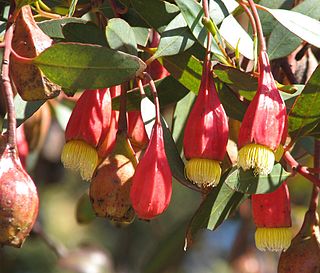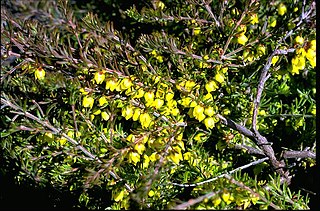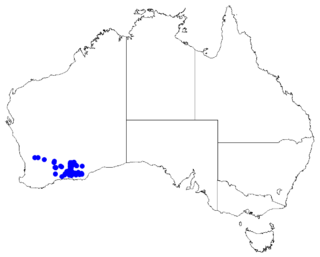| Gunniopsis zygophylloides | |
|---|---|
| Scientific classification | |
| Kingdom: | Plantae |
| Clade: | Angiosperms |
| Clade: | Eudicots |
| Order: | Caryophyllales |
| Family: | Aizoaceae |
| Genus: | Gunniopsis |
| Species: | G. zygophylloides |
| Binomial name | |
| Gunniopsis zygophylloides | |
Gunniopsis zygophylloides, commonly known as the twin-leaf pigface, is a succulent plant in the iceplant family, Aizoaceae. It is endemic to Australia. [1]

In botany, succulent plants, also known as succulents, are plants that have some parts that are more than normally thickened and fleshy, usually to retain water in arid climates or soil conditions. The word "succulent" comes from the Latin word sucus, meaning juice, or sap. Succulent plants may store water in various structures, such as leaves and stems. Some definitions also include roots, thus geophytes that survive unfavorable periods by dying back to underground storage organs may be regarded as succulents. In horticultural use, the term "succulent" is sometimes used in a way which excludes plants that botanists would regard as succulents, such as cacti. Succulents are often grown as ornamental plants because of their striking and unusual appearance.

The AizoaceaeMartynov, nom. cons. is a large family of dicotyledonous flowering plants containing 135 genera and about 1800 species. They are commonly known as ice plants or carpet weeds. They are often called vygies in South Africa and New Zealand. Highly succulent species that resemble stones are sometimes called mesembs.

Australia, officially the Commonwealth of Australia, is a sovereign country comprising the mainland of the Australian continent, the island of Tasmania, and numerous smaller islands. It is the largest country in Oceania and the world's sixth-largest country by total area. The neighbouring countries are Papua New Guinea, Indonesia, and East Timor to the north; the Solomon Islands and Vanuatu to the north-east; and New Zealand to the south-east. The population of 25 million is highly urbanised and heavily concentrated on the eastern seaboard. Australia's capital is Canberra, and its largest city is Sydney. The country's other major metropolitan areas are Melbourne, Brisbane, Perth, and Adelaide.
The greenish perennial shrub typically grows to a height of 60 centimetres (24 in). It has green to yellow-green leaves that are ovate to obovate in shape. Leaves are up to 58 mm (2.28 in) long and 24 mm (0.94 in). It blooms between July and October producing solitary green and yellow flowers. [1]
The plant is found in rocky areas on ranges and on shale or quartzite. It is distributed through north central parts of South Australia and also in the southern portion of the Northern Territory. [1]
The species was formally described by the botanist Ludwig Diels in 1904 in his work with Georg August Pritzel, Fragmenta Phytographiae Australiae occidentalis. Beitrage zur Kenntnis der Pflanzen Westaustraliens, ihrer Verbreitung und ihrer Lebensverhaltnisse. Botanische Jahrbücher für Systematik, Pflanzengeschichte und Pflanzengeographie. This name is often misapplied to Gunniopsis calcarea . [2]

Dr. Friedrich Ludwig Emil Diels, was a German botanist.
Georg August Pritzel was a German librarian and botanical writer.
Gunniopsis calcarea, commonly known as the Nullarbor Gunniopsis or the yellow flowered pigface, is a succulent plant in the iceplant family, Aizoaceae. It is endemic to Australia.










